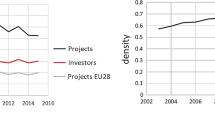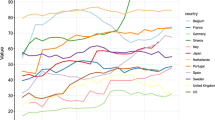Abstract
The present contribution aims at analyzing the economic relationships that international actors set up around the business opportunities progressively offered by the metropolitan area of Naples over Italian political Unification in order to uncover how and in what hands power was vested. From a unique and original database, data are gathered on the whole amount of enterprises and companies operating in the city. Time varying two-mode networks are defined through the relations among economic agents and institutions and then analyzed by means of exploratory network analysis tools.
Access provided by CONRICYT-eBooks. Download chapter PDF
Similar content being viewed by others
Keywords
1 Introduction
Networks—at different levels (transport, communication, finance, etc.)—have been recognized as a key driving force in the rise and expansion of global waves over the time [1]. During the nineteenth century the rise of a cohesive and politically organized global financial elite and its ability to build, and capitalize on, relationships were crucial in allowing capital to move from core financial centers towards peripheral countries, this way exploiting investment opportunities in trade and sovereign bonds as well as in industrialization, technology transfers and infrastructure development (FDI, transport networks, networked cities, etc.).
Before and after Italian political unification (1861), the peripheral area of Southern Italy was a crossroad of international capital flows. It became the hub of a complex network of relations within a space beyond its geographical and economic borders, being embedded in a wider process of integration into the “space of flows” of the developing global capitalism. In this context local actors played a role in fostering these dynamics of integration, as vehicles through which international capital flows found their way to and rooted in Southern Italy.
The present paper aims at analyzing the economic relationships that international actors set up around the business opportunities progressively offered by this peripheral area. It wants to explore how the networks of actors and of business and financial entities reorganized over Italian political unification. Network analysis tools are used in order to analyze the collected data describing temporal two-mode networks in which the actors are the subjects and the events are the business and the financial units. After basic notions about the theoretical and the methodological framework and the details about the data collection process, some first preliminary network results are here reported.
2 The South of Italy in the 1st Global Wave: Context and Data
The present work focuses on the metropolitan area of Naples in the 60-year period between 1830 and 1890. Naples, up until 1861 the capital city of the Bourbon kingdom of the Two Sicilies, was the biggest Italian city in terms of inhabitants (484,026) and, even after Unification, it remained the most important political, economic and financial centre of the entire South of Italy [2]. Indeed, the thirty-year period before 1861 almost entirely corresponds to the long reign of Ferdinand II Bourbon (1830–1859), during which the beginning of railway construction (i.e. 1839 the first Italian railway, Napoli-Portici) along with other infrastructure works (gas lighting) attracted foreign capitalists, in addition to the long-lasting presence of the Rothschilds in Naples. On the other hand, the thirty-year period after Italy’s Unification was marked by massive foreign investment, thanks to the profitable opportunities opened up by broad-ranging urban planning projects (i.e., railways, harbor, public utilities, etc.) [4, 7], on the wave of the modernizing economic policies embraced by the Italian liberal governments, firstly aimed at fostering national market integration through infrastructure investments.
Data about the economic actors and firms, and their relationships, have been directly collected from original archival sources [7]. The collected data are stored in a unique and original database containing the whole amount of enterprises and companies operating in Naples between 1812 and 1913 (source: IFESMez www.ifesmez@unina.it). The present paper is based on data coming from this database. A large amount of information and different kind of networks can be derived from this database [5].
3 The Evolution of the Role of the Economic Actors in Naples: A Network Approach
Given the database, time-varying two-mode networks representing the relationships among economic agents and institutions over the decades have been derived. Formally, a time-varying two-mode network can be represented by a set of K two-mode networks \(\{\mathcal {G}_k\}_{k=1, \ldots , K}\). The k index refers to different time points or occasions [6]. Each network \(\mathcal {G}_k\) consists of two sets of relationally connected units, and can be represented by a triple \({ \cal G}_k\left (V_{1k}, V_{2k}, \mathcal {R}_k \right )\) composed of two disjoint sets of nodes—V 1k and V 2k of cardinality N k and J k, respectively—and one set of edges or arcs, \(\mathcal {R}_k \subseteq V_{1k} \times V_{2k}\). By definition, V 1k ∩ V 2l = ∅, ∀k. In our case, the sets \(V_{1k}= \{a_{1k}, a_{2k}, \ldots , a_{N_k}\}\) are the sets of N k economic actors in the time occasions, whereas \(V_{2k} = \{e_{1k}, e_{2k,} \ldots , e_{J_k}\}\) represents the set of J k economic institutions in which the actors are involved in each time occasion. The edge r ijk = (a i, e jk), \(r_{ijk} \in \mathcal {R}_k\) is an ordered couple and indicates whether or not an actor a ik plays one, or more then one, role in the economic institution e jk. Actors’ and institutions’ attributes that can help in explaining the relational pattern are present in the database.
In this first phase of the analysis, two valued two-mode networks are obtained by collapsing the first three and the second three decades in two time occasions: the value associated to each tie represents how many times and how many different roles an economic actors played in a given firm. In the network 1830–1860, there are 2714 economic actors belonging to 612 institutions for 5091 total links. The 61% of the actors presents degree equal to 1, and the 90% a degree less or equal to 3. This implies that the 90% of actors are occasionally partners or shareholders of some firms during these 30 years; only 31 actors have a degree greater or equal than 10 (the maximun degree is 22). The degree distribution suggests the presence of strong core-periphery structure. In Fig. 1a the two-mode network of these 31 actors with the corresponding firms shows the presence of two communities connected by one firm. As for the second 30 years (1860–1890), the network’s size increases with more dense connections. 19070 actors and 1600 firms are present in the network connected by 28969 total links. Also in this period there is an high percentage of actors (95%) with a degree less or equal than 3 links in the 30 years. In this period, 121 actors have a degree greater or equal than 10, and the maximum degree rises to 45. Thus, also in this case there is a strong core-periphery structure. In the two-mode network of these 121 actors (Fig. 1b) only one large component, divided in almost three communities, is present.
Bipartite graphs for the two-mode networks: years 1830–1860 (a), years 1860–1890 (b). Node’s size: weighted actor degree and event size; Node’s color: orange= actors, grey= consulate, light blue= parliament, blue= society, white= state, yellow= government, black= others. Tie’s size: number of actors affiliated with the same entity
4 A First Discussion
During the nineteenth century, European (and global) economy was fast transforming so did the underlying structural interdependencies of the countries across the cores and peripheries and a marked reconfiguration of power served to reshape main features of business international order. The case study of Naples well exemplifies these changing dynamics, from the point of view of a peripheral area. The two thirty-year business networks here analyzed, capture the shifting interdependencies and power relations between the local business context and foreign actors (agents and firms) featuring some of the effects of the progressive changes in both international banking technology (i.e. since the mid 1850s, Rothschilds vs Pereires/Crédit Mobilier [3]) and Italian political balances (1861). The two analyzed networks account for increasingly dense sets of interconnections between local business environment and foreign agents when the fading-out of Rothschilds financial control (1863) brought other international Pereire-orbiting businessmen and firms to occupy a key position in the local corporate network). The pre-Unitarian network structure (the peripheral position of the Crédit Mobilier) predicts the post-Unitarian one, signaling in advance the early international interest in Southern Italy as a strategic area for realizing the ambitious Saint-Simonian French infrastructure project (railway, ports, etc.) of the Systéme de la Mediterranée (Chevalier 1832).
References
Casson, M., Hashimzade, N.: Large Databases in Economic History: Research Methods and Case Studies. Routledge, London (2013)
Davis, J.A.: Società e imprenditori nel regno borbonico, 1815–1860, vol. 816. Laterza, Bari (1979)
Landes, D.S.: Vieille Banque et Banque Nouvelle: la rèvolution financière du dix-neuvièeme sièecle. Revue d’Histoire Moderne & Contemporaine 3, 204–222 (1956). https://doi.org/10.2307/20527130
Nitti, F.S.: Il capitale straniero in Italia. Laterza, Bari (1915)
Primerano, I., Caiazzo, F., Giordano, G., Schisani, M. C., Vitale, M. P.: Inter-firm networks in Naples before and after Italian political unification. A network analysis perspective. Ital. J. Appl. Stat. 30(1), 143–165 (2018)
Ragozini, G., De Stefano, D., D’Esposito, M. R.: Multiple factor analysis for time-varying two-mode networks. Net. Sci. 3(1), 18–36 (2015). https://doi.org/10.1017/nws.2015.5
Schisani, M. C., Caiazzo, F.: Networks of power and networks of capital: evidence from a peripheral area of the first globalisation. The energy sector in Naples: from gas to electricity (1862–1919). Bus. Hist. 58, 207–243 (2016). https://doi.org/10.1080/00076791.2015.1071796
Author information
Authors and Affiliations
Corresponding author
Editor information
Editors and Affiliations
Rights and permissions
Copyright information
© 2018 Springer International Publishing AG, part of Springer Nature
About this chapter
Cite this chapter
Schisani, M.C., Vitale, M.P., Ragozini, G. (2018). Financial Networks and Mechanisms of Business Capture in Southern Italy over the First Global Wave (1812–1913): A Network Analysis Approach. In: Corazza, M., Durbán, M., Grané, A., Perna, C., Sibillo, M. (eds) Mathematical and Statistical Methods for Actuarial Sciences and Finance. Springer, Cham. https://doi.org/10.1007/978-3-319-89824-7_89
Download citation
DOI: https://doi.org/10.1007/978-3-319-89824-7_89
Published:
Publisher Name: Springer, Cham
Print ISBN: 978-3-319-89823-0
Online ISBN: 978-3-319-89824-7
eBook Packages: Mathematics and StatisticsMathematics and Statistics (R0)





